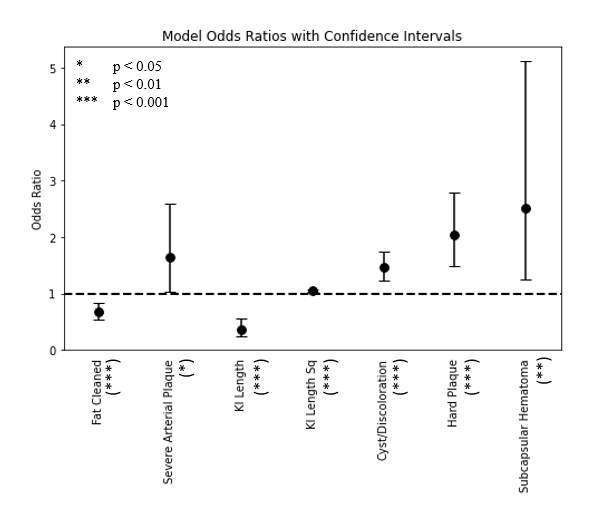The Association Between Renal Anatomy Data and Kidney Utilization
A. M. Placona, C. Martinez, K. McCharen, B. Shean, M. Stuart
United Network for Organ Sharing, Richmond, VA
Meeting: 2022 American Transplant Congress
Abstract number: 542
Keywords: Kidney transplantation, Organ Selection/Allocation, Perfusion
Topic: Clinical Science » Organ Inclusive » 72 - Machine Learning, Artificial Intelligence and Social Media in Transplantation
Session Information
Session Name: Machine Learning, Artificial Intelligence and Social Media in Transplantation
Session Type: Rapid Fire Oral Abstract
Date: Tuesday, June 7, 2022
Session Time: 5:30pm-7:00pm
 Presentation Time: 6:40pm-6:50pm
Presentation Time: 6:40pm-6:50pm
Location: Hynes Room 210
*Purpose: Renal anatomy data, such as hard arterial plaque or discoloration, can be available as PDF attachments uploaded to DonorNet during the organ evaluation process. It is unclear if renal anatomy data are associated with kidney utilization, specifically whether a recovered deceased donor kidney will be transplanted. Our objective was to examine the associations between renal anatomy findings and deceased kidney utilization.
*Methods: We obtained a retrospective cohort of adult deceased kidney donors, with at least one procured kidney, in 2019 (n=10252) from the OPTN database. Next, we downloaded all PDFs associated with these donors. After conducting a preliminary analysis with a Random Forest to identify PDFs of interest, we extracted all machine-readable text and utilized regular expressions to identify renal worksheet pages among PDF data. We applied text-mining techniques to obtain renal anatomy findings of interest. We assessed the association between these renal anatomy findings and kidney utilization by performing multivariable logistic regression controlling for KDPI and whether a biopsy occurred, employing OPO clustered errors
*Results: We identified renal anatomy data for 9433 kidneys from attachments. Severe arterial plaque (OR 1.63, p<0.04, CI 1.03, 2.59]), cysts/discoloration (OR 1.47, p<0.001, CI [1.23, 1.74]), infarcted areas (OR 8.05, p<0.001, CI [3.60, 17.99]), hard arterial plaque (OR 2.03, p<0.001, CI [1.48, 2.80]), and sub-capsular hematoma (OR 2.52, p<0.01, CI [1.24, 5.11]) were negatively associated with kidney utilization. Fat cleaned (OR 0.67, p<0.001, CI [0.54, 0.83]) was positively associated with kidney utilization. Kidney length exhibited a u-shaped relationship with kidney utilization (kidney length OR 0.36, p<0.001, CI [0.23, 0.56], kidney length squared OR 1.04, p<0.001, CI [1.02, 1.06]).(figure 1).
*Conclusions: Given the association between renal anatomy and kidney utilization, as well as post-transplant outcomes, standardizing collection may be warranted.
To cite this abstract in AMA style:
Placona AM, Martinez C, McCharen K, Shean B, Stuart M. The Association Between Renal Anatomy Data and Kidney Utilization [abstract]. Am J Transplant. 2022; 22 (suppl 3). https://atcmeetingabstracts.com/abstract/the-association-between-renal-anatomy-data-and-kidney-utilization/. Accessed December 11, 2025.« Back to 2022 American Transplant Congress

